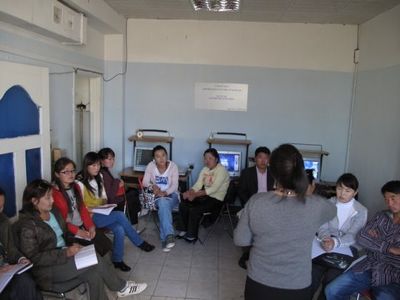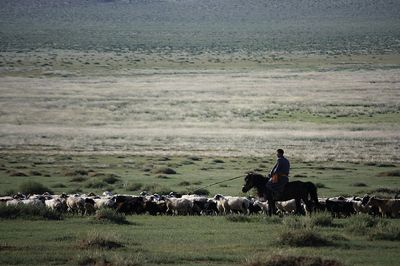Mongolian nomadic families have historically depended on the vast land for their livelihood. In the past, rangeland for their grazing animals had been plentiful, and food and water were readily collected from their surroundings. However, all is that is changing, as climate change is having a negative impact on their way of life.
A recent article by Joshua Kucera in Eurasianet highlights some of these changes [2]:
Global warming is having a harsh effect on Mongolia’s nomadic herders, who comprise about 40 percent of the country’s overall 3 million inhabitants. Since 1940, the mean air temperature in the country has increased 1.6 degrees Celsius. Heat waves are longer, and rain patterns have become “quite variable, decreasing at one site and increasing at a site nearby,” according to an assessment by the country’s Ministry of Nature and the Environment. The Gobi Desert, in the south of the country, is creeping northward.
The desertification of the Gobi Desert is reducing available land for their animals to graze, which are important sources of food. This population is also facing a freshwater crisis, as described by blogger Mandah, who writes about the the water issues facing these communities [3]:
Mongolian high mountain peak’s snowcap and glaciers have been melting and thinning because of the Global Warming. The thickness of the snow melting will become 131 centimeters by 2039. According to the scientist, the whole world will start to face fresh water shortage by 2020 and 108 million people actually have to deal with the fresh water shortage by 2025. Since 1996, Mongolian groundwater level has been decreasing constantly. Some of the biggest lakes in Gobi region such as: Taatsiin tsagaan, Adgiin tsagaan, Ulaan, Orog lakes as well as many other rivers dried up.
Blogger and local botanist Ariungerel adds information about these changes [4]:
Nowadays, the meaning of the phrase “water is treasure” is becoming clearer. Our country is situated far from nearest sea and has less water sources on the ground and underground compared with countries that has enough water sources. Our people range their life in line with water sources, for example: remote area can be utilized only in winter times because running water source is scarce there, only snow is available there. Elders said that they used to use mouthful water to wash their faces and hands, but in the contemporary world, we use many more litters of water for the same reason.
Many of these issues are not well-known within the country, much less around the world. However, a local project called Nomad Green [5] has taken up the initiative to teach the use of citizen media tools like blogs, photogs, and videos to tell the story of this country and some of its environmental problems. The project started in 2009 as partnership between various organizations and institutions [6], and to date several workshops have taken place in the capital city of Ulaanbaatar and other communities around Mongolia.
 [7]
[7]Photo of Nomad Green workshop by Portnoy (Working Man) and used under a Creative Commons license.
The project has already demonstrated positive steps in teaching Mongolians how to use these tools to tell their stories about environmental challenges of their country. Part of this proof is that the two bloggers previously cited in this article, Mandah and Ariungerel are a part of the Nomad Green project, which only adds to number of voices concerned about the environmental future of Mongolia.
